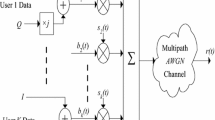Abstract
Mobile communications suffer from cochannel interference, adjacent channel interference and fading. The cell capacity or the number of users per cell is limited by the interference. In this paper we analyze a new blind adaptive array structure called the spectral correlation discriminator array (SCDA), designed to reject cochannel interference for advanced mobile phone service (AMPS) signals. The blind adaptive array exploits the spectral redundancy in the AMPS signals which arises due to the presence of the supervisory audio tone (SAT). SCDA is shown to provide an improvement of 25–30 dB in signal-to-interference plus noise ratio (SINR) in static multipath channels and 10–15 dB improvement of SINR in Rayleigh fading channels. The SCDA is compared to the least squares constant modulus array (LSCMA) and is shown to have better signal selectivity properties. The reduction in interference power can significantly reduce the frequency reuse factor.
Similar content being viewed by others
References
F.A. Cassara, H. Schachter and G.H. Simowitz, Acquisition behavior of the cross-coupled phase-locked (FM) demodulator, IEEE Trans. Comm., COM-32, pp. 195–199, 1984.
Z.D. Stojanovic, M.L. Dukic and I.S. Stojanovic, A new demodulation method improving (FM) system interference immunity, IEEE Trans. Comm., COM-29, no.7, pp. 1001–1010, 1984.
Y. Bar-Ness and H. Bunin, Cochannel interference cancellation and signal separation method, Proc. IEEE Int. Conf. Comm., Philadelphia, PA, 1988.
P. Petrus and J.H. Reed, (AMPS) cochannel interference rejection using spectral correlation properties and an adaptive array, Proc. of IEEE Veh. Tech. Conference, Vol. 1, pp. 300–305, 1995.
P. Petrus and J.H. Reed, Time Dependent Adaptive Arrays, IEEE Signal Processing Letters, pp. 219–222, 1995.
R. He and J.H. Reed, Spectral correlation of (AMPS) signals and its application to interference rejection, Proc. MILCOM Conf., Vol. 3, 1007–1011, 1994.
D.A. Rich, S. Bo and F.A. Cassara, Cochannel (FM) interference suppression using adaptive notch filters, IEEE Trans. Comm., COM-42, no.2, pp. 2384–2389, 1994.
B.G. Agee, S.V. Schell and W.A. Gardner, Spectral self-coherence restoral: A new approach to blind adaptive signal extraction, Proc. IEEE, Vol 78, pp. 753–767, 1990.
L. Castedo and A.R. Figueiras-Vidal, An adaptive beamforming technique based on cyclostationary signal properties, IEEE Trans. on Signal Processing, Vol. 43, no.7, pp. 1637–1650, 1995
H.W. Hawkes, Study of adjacent and co-channel (FM) interference reduction, IEE Proceedings-I, Vol. 138, no.4, pp. 319–326, 1991.
R. Gooch and J. Lundell, The (CM) array: An adaptive beamformer for consant modulus signals, Proc. of ICASSP’ 86, pp. 2523–2526, 1986.
B.G. Agee, Blind separation and capture of communication signals using a multitarget constant modulus beamformer, Proc. MILCOM, pp. 340–346, 1989.
W.A. Gardner, Cyclostationarity in communications and signal processing, IEEE Press, 1994.
R.C.V. Macario, Cellular radio principles and design, McGraw-Hill, Inc., edn. 1, 1993.
W.A. Brown and D.L. Knepp, The effect of multipath propagation on cyclostationary signals, Proc. of the Second Workshop on Cyclostationary Signals, pp. 9.1–9.4, 1994.
B.G. Agee, K. Cohen, J.H. Reed and T.C. Hsia, Simulation performance of a blind adaptive array for realistic channels, Proc. IEEE Veh. Tech. Conf., Vol. 1, pp. 97–100, 1993.
R.H. Clarke, A statistical theory of mobile-radio reception, Bell Syst. Tech. J., Vol. 47, No.6, pp. 957–1000, 1968.
B.G. Agee, K. Cohen, J.H. Reed and T.C. Hsia, Simulation performance of a blind adaptive array for realistic channels, Proc. IEEE Veh. Tech. Conf., Vol. 1, pp, 97–100, 1993.
Author information
Authors and Affiliations
Rights and permissions
About this article
Cite this article
Petrus, P., Reed, J.H. Performance Analysis of the Spectral Correlation Discriminator Array. Wireless Personal Communications 6, 337–359 (1998). https://doi.org/10.1023/A:1008888402989
Issue Date:
DOI: https://doi.org/10.1023/A:1008888402989




